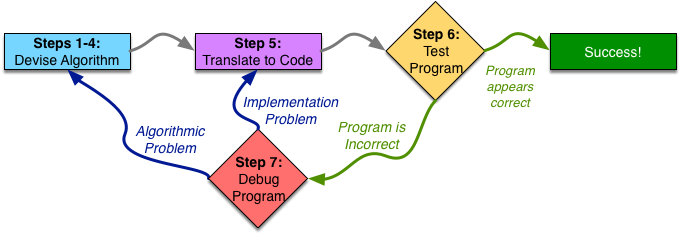Section outline
-
Class Schedule: Programming & Problem Solving Online Class (PC-E) 08:30 AM - 11:30 AM (Saturday)
-
Welcome to Problem Solving! . I am your course teacher and I'm excited to have you in the class and look forward to your contributions to the learning community. To begin, I recommend taking a few minutes to explore the course site. Review the material we’ll cover each week, and preview the assignments you’ll need to complete to pass the course. Click Forum/Understanding to see forums where you can discuss the course material with fellow students taking the class. If you have questions about course content, please post them in the forums to get help from others in the course community.
In this course we will solve the problem using programming language which is basically C. Many novice programmers attempt to dive right into writing the code (in the programming language) as the first step. However, writing the code is actually a much later step in the process. A good programmer will plan first and write second, possibly breaking down a large programming task into several smaller tasks in the process. Even when cautioned to plan first and code second, many programming students ignore the advice—after all, why “waste” 30 minutes planning when you are time-crunched from all the work you have to do. This tradeoff, however, presents a false economy—30 minutes planning could save hours of trying to make the code work properly. Well planned code is not only more likely to be correct (or at least closer to correct), but is also easier to understand—and thus fix.
Good luck as you get started, and I hope you enjoy the course!
-
Course Rationale:
Regardless of the area of study, computer science is all about solving problems with computers. The problems that we want to solve can come from any real-world problem or perhaps even from the abstract world.Computer programming is at the heart of computer science. It is the implementation portion of software development, application development and software engineering efforts, transforming ideas and theories into actual, working solutions.
Course Objective:
The primary purpose of this course is to teach students the basic of pure programming and problem solving. This course provides students with a comprehensive study of the C programming language.The course emphasizes problem-solving and empirical skills through the process of designing,implementing, and executing C programs.
Course Outcomes (CO’s):
CO1 Able to solve computing problems using programming concepts and learn the basic concept of ACM Problem solving techniques. CO2 Able to apply fundamental programming elements including: variable, use of datatypes and data structures, decision structures, loop structures, pointer, string, console,file IO, and functions. CO3 Able to specify the problem requirements, analyze the problem, design the algorithm to solve the problem and implement with the help of programming language CO4 Able to apply the knowledge of programming and problem solving in real file problem.
-
1. Programming in ANSI C- E Balagurusamy.
2. The C programming language. Prentice Hall, 1988, by Dennis Ritchie
3. Teach Yourself C : Herbert Shieldt
-
-
Final Survey:













